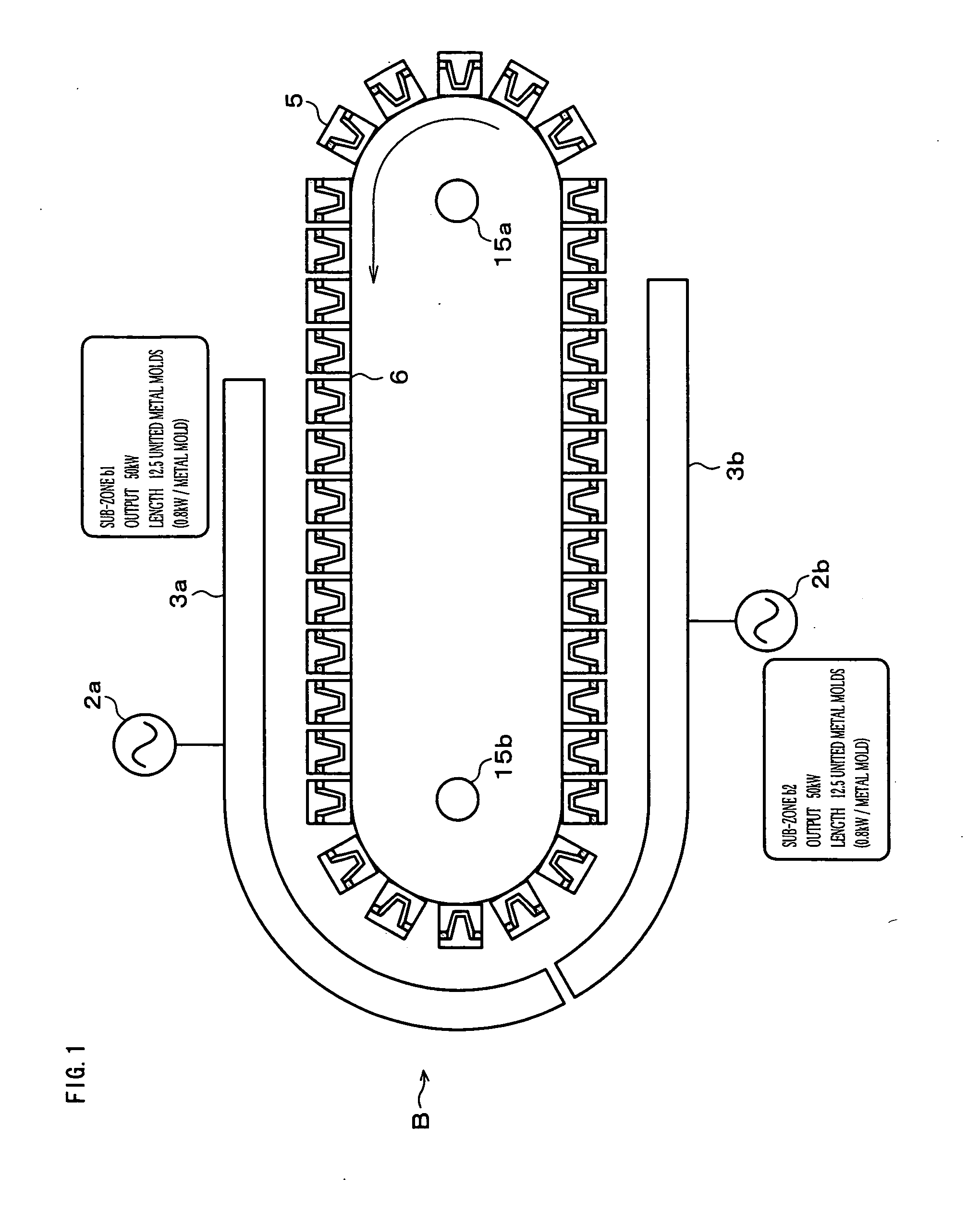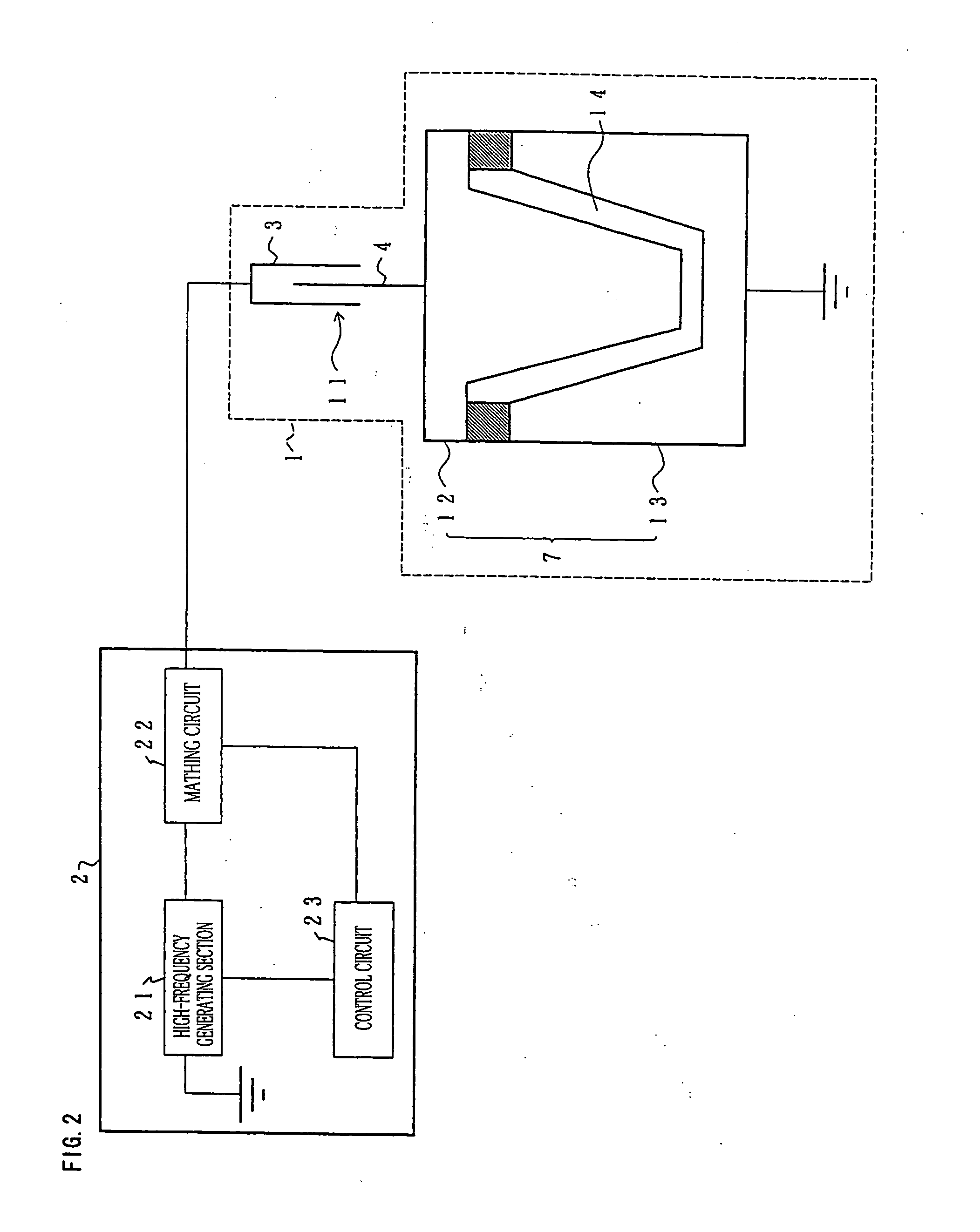Method of manufacturing hot formed object, and device and method for continous high-frequency heating
a manufacturing method and high-frequency heating technology, applied in dielectric heating circuits, baking ovens, cooking vessels, etc., can solve the problems of shortening the molding time of conventional external heating methods, and affecting the production efficiency of hot-formed objects. , to achieve the effect of preventing malfunctioning detection of sparks, preventing high frequency, and preventing damag
- Summary
- Abstract
- Description
- Claims
- Application Information
AI Technical Summary
Benefits of technology
Problems solved by technology
Method used
Image
Examples
embodiment 1
[0110] An embodiment of the present invention is explained below referring to FIG. 1 to FIG. 13. However, the present invention is not limited to this embodiment.
[0111] In a method for manufacturing heated and molded articles in accordance with the present invention, continuously transferring the molds wherein raw materials for molding are placed, passing through an area where high-frequency alternating current is applied (heating zone), and heating and molding the raw materials by generating dielectric heating, in particular, the heating zone is divided into sub-zones, each of which has a power source section (an oscillator).
[0112] Also, in a continuous high-frequency heating apparatus in accordance with the present invention, continuously transferring objects to be heated with electrodes, passing through an area where high-frequency alternating current is applied (heating zone), and generating dielectric heating on the objects, this heating zone is divided into sub-zones, each o...
embodiment 2
[0194] The following description explains another embodiment of the present invention referring to FIG. 14 to FIG. 16, but the present invention is not limited to this embodiment. For convenience, the same numbers are shown for the members having the same function as the members used in the above embodiment 1, with the explanation left out.
[0195] In the above embodiment 1, the heating zone B is divided into two. In this embodiment, the heating zone B is divided into more than three.
[0196] More specifically, for example, as shown in FIG. 14, the heating zone B is divided into five sub-zones, b1, b2, b3, b4 and b5 from the previous part based on the moving direction of the conveyer 6. Each of the sub-zones has power source sections 2a, 2b, 2c, 2d, and 2e as well as a power feeding sections 3a, 3b, 3c, 3d, and 3e, respectively.
[0197] A way to divide the heating zone B, that is, a length of each of the sub-zones (length from the power feeding sections 3a to 3e) or a high-frequency ou...
embodiment 3
[0210] Still another embodiment of the present invention is described below referring to FIG. 17 and FIG. 18 as well as FIG. 26 and FIG. 27. The present invention is not limited to this embodiment. For convenience of explanation, the same numbers are shown for the members having the same function as the members used in the above embodiments 1 and 2 with the explanation left out.
[0211] In the above embodiments 1 and 2, even if the heating zone B is divided into sub-zones, both dielectric heating through the high-frequency heating means and external heating through the external heating means are used in the entire heating zone B. This embodiment includes an area where external heating is only performed, by providing a high-frequency application suspension zone where no high-frequency alternating current is applied, in part of the heating zone B.
[0212] More specifically, in this embodiment, as shown in FIG. 17, the heating zone B is basically divided into five sub-zones explained in ...
PUM
| Property | Measurement | Unit |
|---|---|---|
| Volume | aaaaa | aaaaa |
| Volume | aaaaa | aaaaa |
| Volume | aaaaa | aaaaa |
Abstract
Description
Claims
Application Information
 Login to View More
Login to View More - R&D
- Intellectual Property
- Life Sciences
- Materials
- Tech Scout
- Unparalleled Data Quality
- Higher Quality Content
- 60% Fewer Hallucinations
Browse by: Latest US Patents, China's latest patents, Technical Efficacy Thesaurus, Application Domain, Technology Topic, Popular Technical Reports.
© 2025 PatSnap. All rights reserved.Legal|Privacy policy|Modern Slavery Act Transparency Statement|Sitemap|About US| Contact US: help@patsnap.com



